
Features
Crop Culture
Inputs
Growing in the Green: Celebration for some
January 28, 2011 By Melhem Sawaya
While writing this article, I was constantly reminded of the late Jack Williams, who died of a heart attack last October.
While writing this article, I was constantly reminded of the late Jack Williams, who died of a heart attack last October. Much of the information in this article is due to the work of Jack, or he was a major communicator of it. This article, then, is dedicated in memory of Jack.

|
|
| This feature is dedicated to the memory of my longtime friend, Jack Williams, from whom I learned so much about poinsettias and other crops. Advertisement
|
|
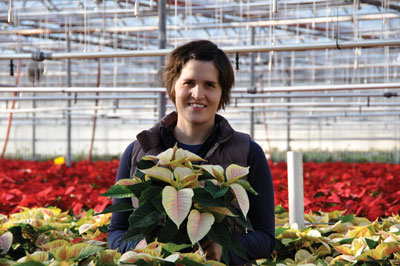 |
|
| Julie Hoff Meyers, of Meyers Flowers in Niagara-on-the-Lake, with ‘Premium.’ It’s good for closely packed growing.
|
|
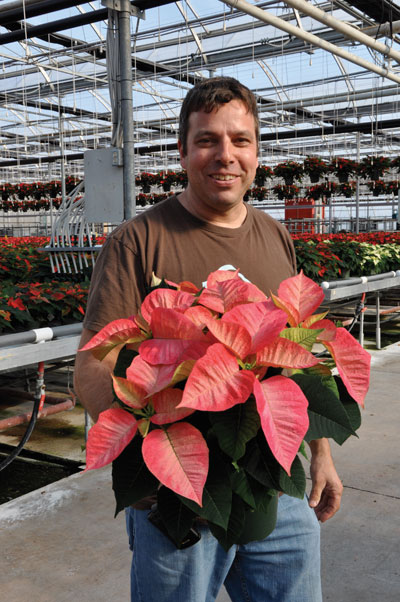 |
|
| Henry Alkema of Alkema Greenhouses in Grimsby, with ‘Premium Ice Crystal,’ a very popular novelty variety with consumers.
|
|
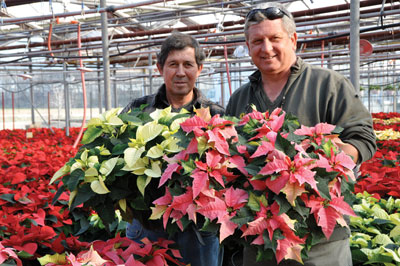 |
|
| John Robero and Mark Miziolek of Waterloo Flowers in Breslau (near Waterloo) with two of their favourite varieties. |
|
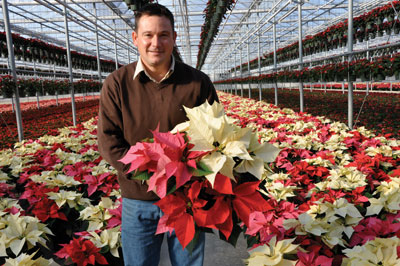 |
|
| Colin Ashby, of Lakeshore Inc. in Jordan Station, with a tricolour presentation from the Enduring series.
|
|
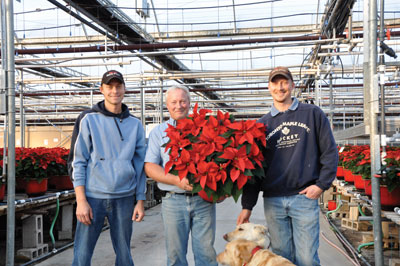 |
|
| Mark, Gord and Steve Valstar, of Scott Street Greenhouses in St. David’s, like the bracts on ‘Classic Red’ because they cover the whole top of the plant.
|
|
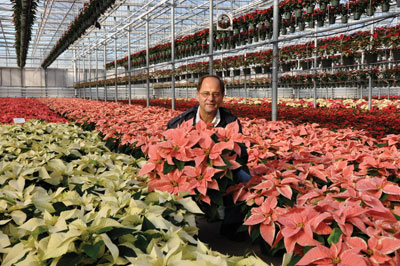 |
|
| Nobody wanted their picture taken with ‘Marble Star,’ but it’s still my favourite.
|
|
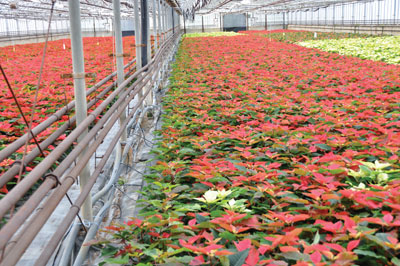
|
|
| Plants showing signs of heat delay, after they were placed too close to heating lines.
|
|
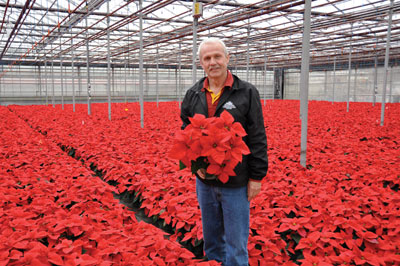 |
|
| Fred Meyers, of Meyers Flowers in Niagara-on-the-Lake, with ‘Premium Red,’ a favourite with consumers.
|
|
 |
|
| No growth regulators and positive DIFF result in spectacularly large bracts.
|
|
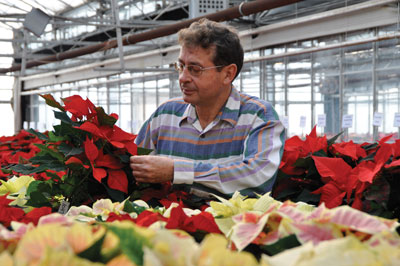 |
|
| OMAFRA’s Wayne Brown coordinates one of the largest poinsettia trials in North America at the Vineland Research and Innovation Centre.
|
|
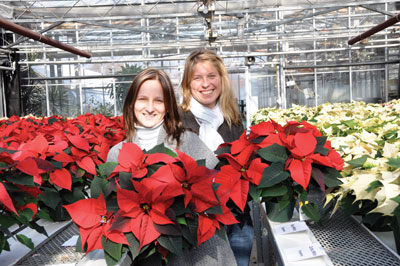 |
|
| Magda Pawlowska and Laura Martindale, from Seacliff Farms of Leamington, were among visitors attending December’s Vineland open house.
|
|
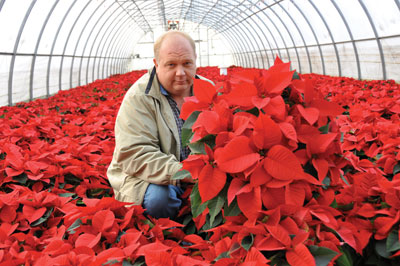 |
|
| Rick Rabb, of CF Greenhouses in Leamington, with ‘Premium Red,’ traditionally one of the season’s best-sellers.
|
|
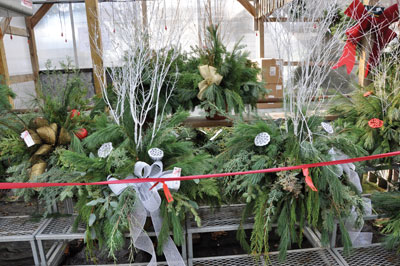 |
|
| Evergreens: are they complementing poinsettia sales or competing with them?
|
|
 |
|
| Peter van Beurden, of Westland Greenhouses in St. Catharines, with a good example of ‘Prestige Red.’
|
|
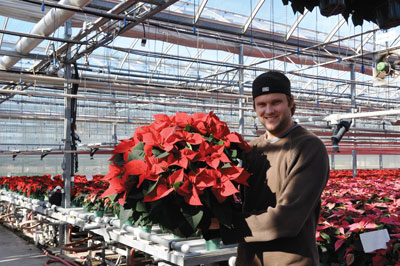 |
|
| Jeremy Van Koeveringe, of Spring Valley Gardens (Niagara) in St. Catharines, has been impressed with ‘Christmas Eve.’ |
|
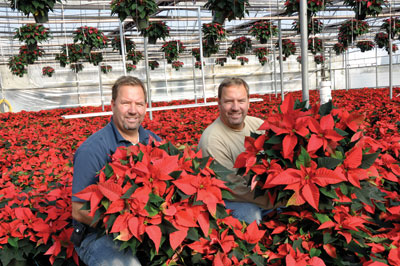 |
|
| Peter and Andy Vander Hoeven, of Vander Hoeven Greenhouses in St. Catharines, are big on the Classic series and plan to increase the percentage next year.
|
|
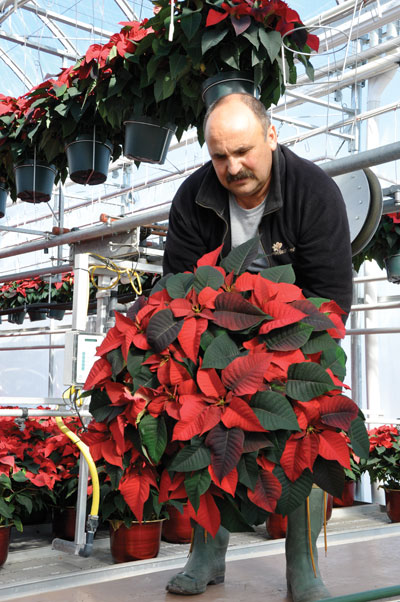 |
|
| Val Zamfir, of Spring Valley Greenhouses, likes ‘Christmas Eve,’ but says it can be too big for some homeowners.
|
Growing any crop for specific shipping dates has many lessons to be learned. Poinsettias are shipped from Nov. 8 to Dec. 23, and there are lessons to be learned every season.
Here are a few variables growers deal with every poinsettia season:
- An ever-increasing number of new varieties.
- Lack of practical culture information on how to grow the new cultivars. If there is information available, it usually pertains to certain geographic areas, and this makes it all the more confusing.
- The weather is never the same year to year, so trying to follow the same environmental parameters could be a disaster.
- Introduction of a new soil mix without any proper testing.
Introduction of a new chemical (pesticide, fertilizer, wetting agent, or any other new product) without much testing (or any testing at all), resulting in thousands of dollars in shrinkage. The number one shrinkage factor in horticulture is the introduction of new products without proper testing.
Introducing a new cultivar to the buyer, who then forces it on the grower, leads to a lot of money spent advertising a product that cannot be delivered by the grower because:
- Its newness creates growing challenges.
- We do not know the consumer appeal for that cultivar.
- The breeder or variety broker is not ready to ship quality cuttings to growers who don’t know exactly how to grow a crop that is also new to them.
So, before trying a new cultivar on a large scale, test it for production know-how, customer appeal (which is more important), and shipping and shelf life at the consumer level.
SALES AND PRODUCTION
■ This past season was different for both poinsettia sales and production due to the weather. Sales started very slow but, at the end, the entire poinsettia crop was sold. This is the third year in which production met market demand. However, I hasten to add that the few growers who increased production by five per cent still had that five per cent in their greenhouses at the end of the season. And while most greenhouses were empty, what about the sell-through at retail? This is a major concern because if stores don’t make a profit on an item, they will buy much less or eliminate it completely the next year.
There are still growers who grow on speculation, hoping a grower/broker will take the crop off their hands. This didn’t pan out for them for the following reasons:
- The season started late and every grower/broker naturally wants to ship their own crop and, if they need more product, they will try to find it.
- The weather was perfect for bud-set because the temperature in late September (when bud-set is supposed to take place) was perfect.
- Light levels in October and November were the highest I can remember over the last 30 years.
The weather conditions meant many varieties were ready to ship by Nov. 5-7; with normal natural light levels, they would not have been ready until Nov. 25.
People were not thinking about indoor decorations when outdoor temperatures were in the teens. On the other hand, sales of greens increased 10-20 per cent again this year!
The early bud setting and large bract development did not lead to cultural problems at the end of the shipping dates, even on overly mature bracts.
BRACT EDGE BURN (BRACT DISORDER)
■ Bract disorders have many causes; it’s not just calcium deficiency. The connection between calcium deficiency and bract disorder overshadows other causes because some tests show that sprays of calcium can minimize the symptoms. As growers, we mainly concentrate on how to correct the problem rather than how to prevent it – just like taking Aspirin, Tylenol or some other medicine to get rid of the headache instead of finding the reason for the pain.
I used to get severe headaches but only on weekends. So I took pain pills, but it meant I was almost always drowsy.
Then I decided to switch from caffeinated to decaf coffee and, after three weeks, the weekend headaches disappeared. I realized the cause of my headaches was the sudden withdrawal – every weekend – from the normal six to eight cups of caffeinated coffee I drank each weekday, to the weekend when I drank no coffee at all!
Getting back to plants, another example of correcting the symptoms rather than preventing the cause is applying iron chelate to counter yellow tips on calibrachoa or petunias. Just as there are many ways to prevent yellowing on calibrachoa, so too are there a number of remedies to prevent bract edge disorder on poinsettia. Here are a few:
Reduce humidity in the greenhouse: If humidity is too high, the plants are getting most of the moisture in the air on their leaves so the roots don’t have to work as much, or hardly at all. Any nutrients we provide the plant are not getting to where they belong.
The worst scenario is when we use flood floor irrigation, or some other kind of subirrigation, where the heat is delivered primarily from the bottom. This evaporates much of the water from the pot and builds up humidity. This humidity damages the root tips, which then prevents nutrient uptake, leading to some nutrient deficiencies.
SUSPENDED HEAT PIPES
■ That is why many greenhouses – mainly vegetable greenhouses – have suspended heat pipes installed with adjustable cables to enable them to position the heat just above the leaf canopy so the plants will work on absorbing all the nutrients provided to them.
Use a media that drains well: Well-draining media is used to avoid root growth without the hairs that are the implement of nutrient transportation. It is what I call “avoiding swamp roots.”
Maintain good root growth: Establish a healthy root system early on in the crop because a strong, well-rooted plant will withstand minor, unfavourable plant growth conditions.
Reduce fertilizer EC levels: High salts at the finishing stages of the crop could lead to bract disorders if the crop dries up too much.
Avoid pesticides on bracts: Some pesticides, if applied at bract colouring or even earlier, could and will cause Bract Edge Disorder. Thiodan is one example.
Balance fertility: Maintain proper ratios of potassium, calcium and magnesium. The proper ratio is potassium – 3, calcium – 2, and magnesium – 1. The total EC for the last three weeks should be 0.5-0.6.
ENCOURAGE CALCIUM UPTAKE
■ Provide a calcium uptake environment: Make every effort to ensure the nutrients are being taken up by the roots. For example, horizontal air flow fans are important for two main reasons: they provide a gentle air movement that will encourage evaporation, which then encourages nutrient uptake; and they even-out temperatures throughout the greenhouse. Also, make sure the pH is between 6.0-6.5, because calcium is not available at low pH levels.
Cultivar selection: Select cultivars that are resistant to Bract Edge Burn.
If all this fails, some experiments have shown that spray applications of calcium could be helpful. A spray of 300-400 ppm of calcium will supplement calcium buildup in the bracts. Spraying the bracts has to happen when leaf temperatures are not very high and it is better to spray early in the morning to allow the bracts to dry before sunset.
If you decide to spray calcium, use only a high-grade purity of calcium.
To take full advantage of the calcium sprays, you must start spraying as soon as the bract colour shows and continue spraying every six to seven days until the pollen-shed stage.
This past season, whether calcium sprays were applied or not, Bract Edge Burn was minimal. This was mainly due to the high solar energy that prevailed throughout October. As well, growers were more proactive because of the more serious problems in 2009.
Another factor is that far fewer chemicals are being used, and we know that some chemicals can cause the problem or symptoms similar to it.
LESSONS FROM THE SEASON
■ If we learned anything from this season’s poinsettia crop, it was that about 10 per cent of sales occurred between Nov. 10 and 24, 80 per cent between Nov. 25 and Dec. 10, and the remaining 10 per cent between Dec.11 and 20.
The lesson is that old, ripe bracts can cause problems and that timing the crop according to these projections is a very important aspect of a successful season.
And last but not least, a poinsettia crop will be profitable if no shortcuts are taken, if you grow only what is sold, and if you give the plants enough space and all the natural light possible.
CROP COOKBOOK LINK
■ In a followup to last month’s feature (Jan. 2011, pg 12), there is now a direct website link to my crop production cookbook.
This is the link to the actual page:
www.focusgreenhousemanagement.com/cropcookbook .
And this is the link to the document:
www.focusgreenhousemanagement.com/cropcookbook/CROP%20COOKBOOK.xls.zip
Melhem Sawaya of Focus Greenhouse Management is a consultant and research coordinator to the horticultural industry. Comments on this or any other article are always welcome at mel@focusgreenhousemanagement.com, or by visiting www.focusgreenhousemanagement.com or www.sawayagardentrials.ca .
Print this page